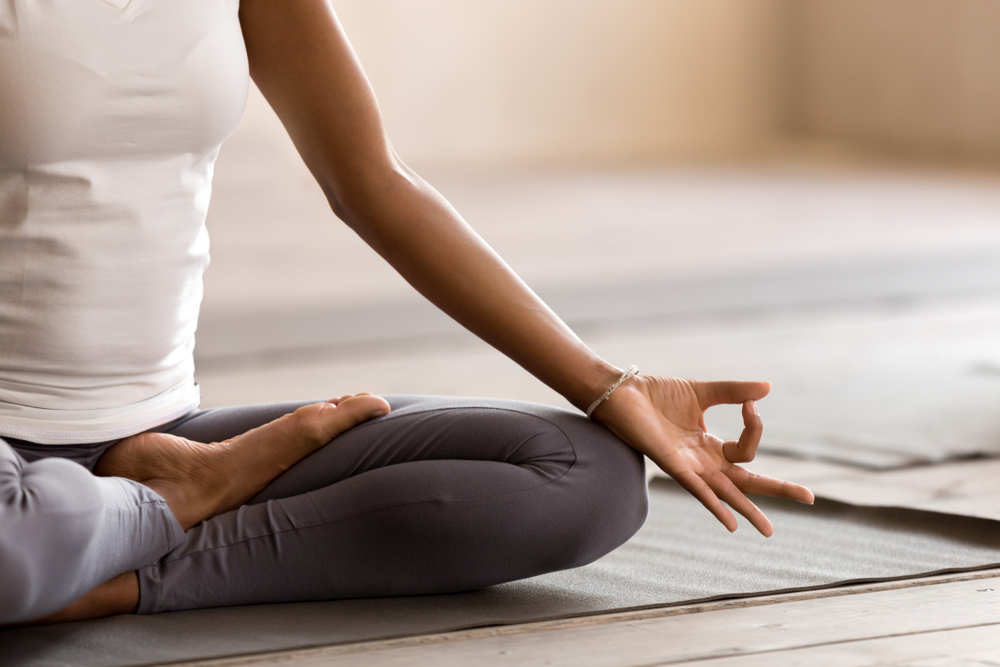 When you think of meditation, do you think of someone sitting cross-legged saying, “ommm” to themselves over and over again? Or, do you think of simply sitting still and clearing your mind of any thoughts whatsoever?
When you think of meditation, do you think of someone sitting cross-legged saying, “ommm” to themselves over and over again? Or, do you think of simply sitting still and clearing your mind of any thoughts whatsoever?
Those are two useful methods of meditation, but did you know there are more?
According to Wikipedia, meditation can be defined as a technique used to train attention and awareness, and achieve a clear and calm mental state.
That leaves a lot of room for many different techniques that can help meet those ends.
In this article, we’re going to talk about 2 classic meditation techniques and 7 new meditation techniques.
These techniques can help you with everything from stress to anxiety to depression to concentration to memory. That’s a lot of benefits from a few easy changes you can make in your daily life.
Two Classic Meditation Techniques
The first two meditation techniques we’re going to talk about today are ones you’re likely already familiar with. We’re going to dive into them anyway because these basics are helpful to keep in mind when practicing the other techniques.
Following Your Breath
Following your breath is a classic meditation technique that can be practiced anywhere.
In the classic sense, you would be sitting, closing your eyes, but honestly, you can do this anywhere. You can practice this way at home, on the bus, at parties, or even at work. Anywhere or anytime that you are alive, you can practice breathing meditation.
To start breathing meditation, wherever you are, start paying attention to when you breath in.
Follow your breath as it enters your body. Notice the feeling of it entering in through your nose and going into your chest. Notice how your stomach rises as your lungs fill with air.
Most people think about breathing into your lungs as you breath in, and this makes sense. Your lungs are, after all, where the air goes. That said, it can be more helpful to think of breathing into your belly. This is because your diaphram, which controls your breath, expands and contracts into your stomach area.
Try this: lay flat on your back with your hands on your stomach. Allow yourself to breath in and out naturally. Notice how your hands rise and fall with your breath. Now you can see what we mean when we say, “breath into your stomach.”
When you practice breathing meditation, follow your breath from your nose all the way down to your stomach. Notice how the different parts of your body expand to allow this life-giving oxygen to come into your lungs.
Then, as you breath out, notice how your stomach shrinks to let the air back out. Focus on the feeling of the breath leaving out your nose again.
Sometimes when you first start noticing your breath, you’ll find yourself suddenly gasping or yawning to take in a bigger breath. This is normal.
When you practice this meditation, try setting a timer for 5 – 10 minutes. After you’ve practiced for a while, you might want to try this meditation for longer, but 5 – 10 minutes is great for a start. During this time, try to do nothing but focus on your breathing.
Start with the feeling of breath coming in through your nose. Follow that feeling down into your lungs and through your belly. Allow it to rest that way for one second, or one count. Then follow your breath back out of your body.
It can often help to keep your hands on your belly through this exercise.
If you find your mind starting to wander during this time, try the next meditation technique.
Noting
It’s common for your mind to wander during meditation, especially at the beginning. A lot of people get frustrated by this. That said, there’s no need to get frustrated with yourself.
Here’s what experienced practitioners do when they find their mind wandering away from their meditation: they just note it.
When you find your mind start to wander, just note that your mind is wandering.
As certain things around you begin to grab your attention, simply note that it’s happening. For example, if you’re trying to meditate but there’s a sound outside that is distracting you, calmly note what is happening. Let’s say it’s the sound of construction. When it starts to pull your attention away, simply note to yourself, “I hear construction outside and it’s distracting me.”
In some forms of meditation, you can simply sit upright, close your eyes, relax your mind, and then simply notice what comes and goes. As thoughts come in, you note the thoughts. As noises come in, you note the noises. As sensations come in, you note the sensations.
This is also something you can do whenever you’re doing any kind of meditating, including the meditations in the rest of this article.
Seven Alternative Meditation Techniques
When Westerners think of meditation, they typically think of the first two examples above. However, many of these techniques are common in other cultures, including Buddhism.
Some of these are things you’ll want to set aside a specific time to do, but others are things you can do throughout your day.
Meditation on Sensations
For this meditation, you can either be sitting straight up, or lying on your back.
Close your eyes and relax your mind.
Start at your feet. Try to center your consciousness in your feet. Feel what it feels like to be in your feet.
Note any sensations occuring in your feet. If you feel any pain, don’t try to run away from it. Accept that it is what it is. If possible, try smiling at your pain.
As you’re focusing on your feet, note any pressure points where your feet make contact with the floor. See if you can notice the feel of any socks you have on. If you’re not wearing socks, note the feel of the air on your feet.
When you’re done noticing all the sensations in your feet, move up to your ankles. Repeat the same steps you used on your feet for your ankles.
As you complete this meditation, move from your ankles to your legs. Then move from your legs to your knees. Then move from your knees to your thighs. Move from your thighs to your hips. Then move from your hips to your abdomen. Move from your abdomen to your chest. Then move from your chest to your shoulders. Move from your shoulders down into your arms. From your arms, move down into your fingers. From your fingers, move back up your body into your neck. From your neck, move up into your jaw. Finally, move from your jaw into your forehead.
As you move through your body focusing on each sensation, try not to label those sensations as “good” or “bad.” Allow each sensation to simply be.
When your mind wanders, note that it’s wandering and bring your focus back to each body part.
Meditation on Sounds
For this meditation, sit up in a comfortable position. It can be helpful to set a timer for 5 – 10 minutes to start with.
Take a deep breath and close your eyes.
With your eyes closed, allow your mind to drift to the sounds in your environment.
The longer you listen, the more you’ll notice many different sounds arising. As each new sound arises, allow your mind to hold that sound fully.
Hold each sound in your mind for a minute or two, then allow yourself to search for the next sound. Then, hold that one fully.
As with the sensations in the last exercise, try not to label the sounds you’re hearing as either “good” or “bad.”
Meditation on Sights
This meditation is a lot like the last one and also kind of opposite. This is one of the few meditations you do with your eyes open.
Start in a cross-legged position, sitting straight, with your chin up, and shoulders relaxed.
Try to keep distractions as limited as possible during this meditation. It’s best to do this in a quiet environment by yourself, if you can.
After you’re seated, allow yourself to look around the room, drinking in everything that you see. Pay attention to details you may not have noticed in the room before.
As you’re looking around, find one thing to focus. Notice everything you can about that object. Note the play of shadows. Allow yourself to bask in the colors of whatever you’re looking at. Pay attention to whether the colors are rich or subdued. Some people prefer to focus on objects with rich colors for this exercise.
This is a meditation that allows you to be deeply in touch with your surroundings, but because looking around can also be distracting, you might want to set a timer and limit your time to about 5 minutes.
Meditation on the Space Around You
In Western traditions, there are four elements: earth, water, fire, and air. In Buddhism, there are six elements: earth, water, fire, air, space, and consciousness.
Of all the elements, space is perhaps the most elusive. It seems obvious to us at first, but on closer inspection, it gets weirder.
To start this meditation, sit in a cross-legged position and take a quick look around you. Close your eyes. With your eyes closed, try to imagine the space between you and the walls. Imagine the space from your nose to your toes. Imagine the space between you and the ceiling.
Imagine what’s filling that space.
Imagine the air that’s occupying that space. Imagine all the photons whizzing back and forth around the room between you and everything else.
Now, pay attention to the space you’re occupying – the space that feels like yours. Pay attention to the space within your body, keeping in mind that most the atoms that make up “you” are 99% empty space.
Finally, consider this: while you’re sitting doing your meditation, you’re on a planet that is turning around its axis at 1,000 miles an hour. At the same time, it’s also spinning around the sun at 67,000 miles per hour.
That means that the space we think we’re occupying is being whisked away 30 kilometers away from us at every second. That space we think is ours is here and gone in a fleeting moment.
This touches on two key Buddhist principles: impermanence and non-self. Both are central to Buddhist philosophies and many meditation practices.
Firstly, it touches on impermanence by helping us realize that even what we think is here is constantly moving and being exchanged. Secondly, it touches on non-self reminding us that there are elements of what we think of as “ourselves” that aren’t really a part of us. They belong to something else and we’re only borrowing it for fleeting moments.
Walking Meditation
This is one of my favorite meditations. You can do it as a concentrated meditation all by itself, or you can do it while you’re on your way from one place to another as you go about your day.
In this meditation, you’re going to be paying attention to the feeling all throughout your body as you walk.
As you take a step, notice the feel of your heel leave the ground, shifting weight to the ball of your foot as it pushes you forward. Pay attention to the feeling of the muscles in your legs engaging.
After you lift your foot off the ground and step back down, pay attention to the feeling of your heel striking the ground.
Notice how your stomach muscles engage as your body shifts weight from one foot to the other – from one side of the body to the other.
Do the same thing for the other foot and leg as you take another step.
As you walk to wherever you’re going, try to keep your focus on the feelings in your body as you move forward. If you notice your mind wandering, do what we talked about earlier. Note that your mind has wandered somewhere else and gentle invite it to come back to your walking.
This way of staying deeply grounded in what you’re doing can help keep your mind clear and alert, ready for whatever the day brings you.
Eating Meditation
Did you know you can meditate while eating? This meditation and the next are much like the walking meditation. As you go about what you’re doing, pay attention to every sensation.
This meditation can also be great for people who are trying to diet or lose weight.
In this meditation, you’re going to sit down for a meal. If possible, sit down for a quiet meal where you can concentrate by yourself.
As you get ready to eat, slow down. Don’t be in a rush to “scarf” everything down.
Take one bite at a time. As you bite into your food, note all the textures you can immediately feel in your mouth. Then, as you begin chewing, try to pick out each individual flavor.
Chew slowly and don’t be in a rush to take your next bite.
As you eat, continue to take it one bite at a time. Don’t be doing anything else while you’re eating. When you eat, be fully engaged in eating.
Dishes Meditatoin
I still remember the first time I read a book by celebrated Viatnamese monk Thich Nhat Hanh talking about doing the dishes. I had never considered the concept of really paying attention to your chores before.
The idea here is similar to walking and eating meditation.
In this example, we’ll talk about doing the dishes, but it can apply to any chore you do throughout the day.
As you start doing the dishes, notice the feeling of the water running over your hands. Notice the feel of each dish in your hands.
Take your time and don’t rush.
It may feel like a chore (because it literally is), but if you’re rushing through things, letting your mind race forward to a time other than now, it’s a little like not being really alive in the moment. When we add up all the times we’re not really alive because our minds aren’t with us in the present, think of how much time we spend not being alive.
We’ve brought you a total of 9 great meditation techniques – 2 classic and 7 alternatives. We hope you’ll be able to incorporate these meditations into your day. We hope they’ll help you with any stress, anxiety, or even depression you may be experiencing.
The more you practice, the greater benefit you’ll experience.




